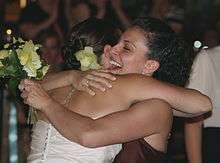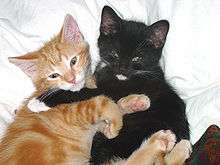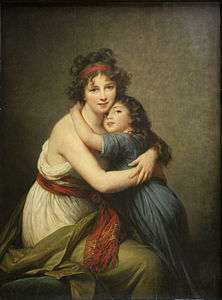Hug
A hug is a form of physical intimacy, universal in human communities, in which two or more people put their arms around the neck, back, or waist of one another and hold each other closely. If more than two persons are involved, this is informally referred to as a group hug.
Etymology
The origins of the word are unknown but two theories exist. The first is that the verb "hug" (first used in the 1560s) could be related to the Old Norse word hugga, which meant to comfort. The second theory is that the word is related to the German word hegen which means to foster or cherish, and originally meant to enclose with a hedge.[1]
Characteristics

A hug, sometimes in association with a kiss, is a form of nonverbal communication. Depending on culture, context and relationship, a hug can indicate familiarity, love, affection, friendship, brotherhood or sympathy.[2] A hug can indicate support, comfort, and consolation, particularly where words are insufficient. A hug usually demonstrates affection and emotional warmth, sometimes arising from joy or happiness when reunited with someone or seeing someone absent after a long time. A non-reciprocal hug may demonstrate a relational problem. A hug can range from a brief one second squeeze, with the arms not fully around the partner, to an extended holding. The length of a hug in any situation is socially and culturally determined. In the case of lovers, and occasionally others, the hips may also be pressed together.
Unlike some other types of physical contact, a hug can be practiced publicly and privately without stigma in many countries, religions and cultures, within families, and also across age and gender lines,[3] but is generally an indication that people are familiar with each other. Moving from a handshake (or touch-free) relationship to a hug relationship is a sign of a closer friendship such as best friends.

An unexpected hug can be regarded as an invasion of a person's personal space, but if it is reciprocated it is an indication that it is welcome. Some Western culture commentators advise avoiding hugs at work to prevent uncomfortable moments, especially with people who dislike hugging.[4] Also, a person, especially a child, may caress and hug a doll or stuffed animal. Young children will also hug their parents when they feel threatened by an unfamiliar person, although this may be regarded as clinging onto rather than hugging because it demonstrates a need for protection rather than affection.
Cultural aspects
While less common, hugging may be undertaken as part of a ritual or social act in certain social groups. It is a custom in Latin cultures such as France, Spain and Latin America for male friends to hug (as well as slap each other on the back) in a joyous greeting.[5] A similar hug, usually accompanied by a kiss on the cheek, is also becoming a custom among Western women at meeting or parting. In Portugal and Brazil, it is common, mostly among males, to finish letters and emails with Um abraço or Abraço followed by the sender's signature. Similar formulas may be used in oral communication. In the Roman Catholic rite of the Holy Mass a hug may be substituted for a kiss or handshake during the kiss of peace ritual.

In May 2009, The New York Times reported that "the hug has become the favorite social greeting when teenagers meet or part these days" in the United States.[6] A number of schools in the United States have issued bans on hugs, which in some cases have resulted in student-led protests against these bans.[7][8]
A Canadian journalistic investigation in 2015 noted the popularity of the hug in bromance, among young francophone adults in Quebec.[9]
Some cultures do not use hugging as a sign of affection or love, such as the Himba in Namibia. During the Islamic fasting month of Ramadan, it is halal (permissible) for someone to hug one's significant other during daylight hours if one has self-control. However if accompanied by libidinous urges, it is haram (sinful).[10]
Health benefits
Hugging has been proven to have health benefits. One study has shown that hugs increase levels of oxytocin and reduce blood pressure.[11]
Group hug
A group hug has been found to be a useful tool in group therapy to cement a sense of cohesion among the participants after a session,[12] although it may cause discomfort for group members who shy away from physical contact.[12]
Cuddling
Cuddling is a related form of physical intimacy in which two people hold one another with each person's arms wrapped around the other's body. Cuddling can be with family members, friends or lovers. In 2014, British sociologists Eric Anderson and Mark McCormack published a study which shows that 93% of British heterosexuals student-athletes had spooned or cuddled with a male friend, as a sign of friendship.[13][14] Similar to hugging, cuddling is a more affectionate and intimate embrace, normally done for a longer period of time (usually lasting from a few minutes to several hours). In contrast to hugging, which can often be a nonverbal greeting or parting tradition, cuddling is usually shared between two people who are lying down together or sitting somewhere in an intimate manner. Like hugging, cuddling makes the body release oxytocin, which has a variety of effects.
Cuddling business
Cuddling has become a profitable business worldwide for the many ‘professional cuddlers’ who offer their cuddling services for a fee. Professional cuddlers promote their business as non-sexual and offer it those who are missing the touch and connection of another person.
Some professional cuddlers prefer to open retail shops while booking is available via official websites. One of the first ones, Cuddle Up To Me, was launched in Portland, Oregon by Samantha Hess and gained a lot of media attention worldwide.
Following the success of Cuddle Up To Me, a number of online startups emerged. While some suggest choosing from a great variety of cuddlers (both male and female), others let anyone run their own business in any country. Cuddlr was the first mobile app (launched in 2014) and is mainly focused on offering free hugs. CuddleUp.com launched in early 2015 and is a network which connects professional cuddlers with clients and helps the latter hire a spooning partner. CuddleUp.com removes the barrier to entry and allows virtually anyone with access to the internet become a professional cuddler.
Another way of running a cuddling business is cuddle parties (or cuddle workshops, usually paid).[15]
Despite not everybody approving this kind of relationship and business model, it has proven to be successful. For example, Cuddling Con crowdfunding campaign has raised $169,000 and the Cuddlr app has hundreds of thousand downloads.[16]
In non-humans

Patricia McConnell notes that dogs tend to enjoy being hugged less than humans and other primates do, since canines interpret putting a limb over another animal as a sign of dominance.[17]
- Hugging in art
-

Madame Vigée-Lebrun et sa fille, by Louise Élisabeth Vigée Le Brun, 1789
-
.jpg)
The Kiss, by Francesco Hayez, 1859
-

Glassy embrace, a glass sculpture depicting a hug
See also
References
- ↑ Online Etymology Dictionary
- ↑ Kathleen Keating (1994). The Hug Therapy Book. Hazelden PES. ISBN 1-56838-094-1.
- ↑ Duranti, Alessandro (June 1997). "Universal and Culture-Specific Properties of Greetings". Journal of Linguistic Anthropology. 7 (1): 63–97.
- ↑ "A New Rule For The Workplace: 'Hug Sparingly'". NPR. 2014-01-11.
- ↑ William Cane, The Art of Hugging: The World-Famous Kissing Coach Offers Inspiration and Advice on Why, Where, and How to Hug, St. Martin's Griffin, USA, 2013
- ↑ Kershaw, Sarah (2009-05-27). "For Teenagers, Hello Means 'How About a Hug?'". The New York Times. Archived from the original on July 14, 2011. Retrieved 2009-05-29.
- ↑ Grant, Denise (2010-04-15). "Students pan hugging ban".
- ↑ "School Bans Hugs Over 2 Seconds". 2008-03-02. Archived from the original on May 16, 2008.
- ↑ Lili Boisvert, radio-canada.ca, Bromance : ces gars qui craquent pour leurs amis, Canada, January 19, 2015
- ↑ Archived October 20, 2014, at the Wayback Machine.
- ↑ "How hugs can aid women's hearts". BBC News. August 8, 2005. Retrieved 2008-11-28.
- 1 2 Albert Pesso, Movement in Psychotherapy: Psychomotor Techniques and Training (1969), p. 92-93.
- ↑ Eric Anderson, Mark McCormack, Journal Men and Masculinities, Cuddling and Spooning: Heteromasculinity and Homosocial Tactility among Student-athletes, UK, March 12, 2014
- ↑ HENRY ALFORD, Journal nytimes.com, The Bro Hug: Embracing a Change in Custom, USA, September 26, 2014
- ↑ "Fancy snuggling up to twenty strangers for FOUR hours? Join the 'cuddle club' where you'll pay £29 for 'therapeutic touching' sessions". MailOnline. Retrieved 27 April 2015.
- ↑ "Professional Cuddlers Embrace More Clients". The Wall Street Journal. Retrieved 27 April 2015.
- ↑ Patricia McConnell (June 4, 2002), The Other End of the Leash (1st ed.), Ballantine Books, ISBN 978-0-345-44679-4
External links
-
 Media related to Hugging at Wikimedia Commons
Media related to Hugging at Wikimedia Commons